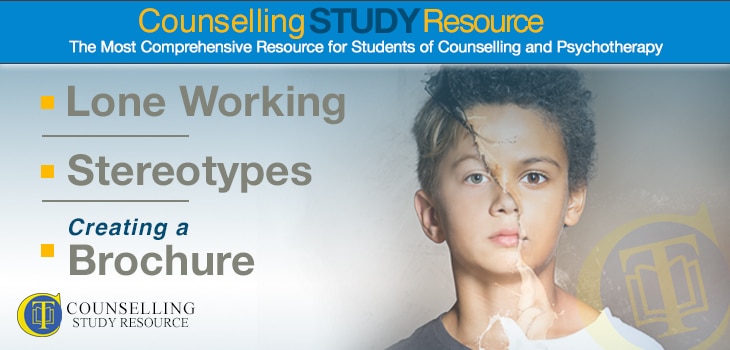Lone Working
If your counselling work involves you visiting clients in their homes, or seeing clients alone at your home, it is important to consider how best to ensure you stay safe. Rory and Ken give some top tips on this:
- Plan ahead for every eventuality.
- If working for an agency, make sure you are aware of its lone-working policy.
- Develop a system so that if you fail to return from an appointment, someone can find out where you were going.
- Always carry a mobile phone, but do not over-rely on it – in an emergency, it would not necessarily be straightforward to use it, and trying to do so may even distract you from what is going on around you.
The Suzy Lamplugh Trust offers excellent advice and resources to help keep lone workers safe.
Counselling Student Library
On-demand access to a rich lecture library covering theory, skills, and professional development for counselling students—Mapped to the UK awarding body criteria
“The Student Library has been BRILLIANT, I can’t recommend it enough!
It has been a lifeline in helping me prepare for practice and my first clients. If you’re considering it, go-for-it, it’s absolutely worth it!”
Kelly – Graduated and now in practice.
Stereotypes
Our experience of past events can influence how we view future interactions (so acting as a type of defence mechanism), but we do not always need direct experience in order to stereotype. For example, we can be heavily influenced by the media and by authority (e.g., government).
The term ‘stereotype’ was coined in the 1920s by Walter Lippman, in his book Public Opinion. Charles Ramirez Berg, Professor of Media Studies at the University of Texas, described aspects of stereotyping in his book Latino Images in Film: Stereotypes, Subversion, and Resistance. Rory describes seven of these aspects:
- Stereotypes are applied with rigid logic.
- Stereotypes may have a basis in fact – termed the ‘kernel of truth’ by psychologist Joshua Fishman.
- Stereotypes are believed – with psychologist Gordon Allport theorising that attitude to a group is usually bonded to a belief about the group.
- Stereotypes are simplified generalisations – the complete opposite to what counselling and psychotherapy are all about.
- Stereotypes can be ideological – created by power and authority to achieve dominance of their ideas.
- The in-group stereotypes itself – meaning that clients who are members of such groups may struggle to see themselves as individuals.
- The antidote to stereotyping is knowledge – meaning we must educate ourselves (through our own research – not by asking clients) if we are to provide the best service to our clients.
Rory uses examples to illustrate how these aspects of stereotyping relate to the world of counselling and psychotherapy, including a story of what can happen if a counsellor relies on stereotypes as the basis of offering supportive services to individuals.
Counsellor CPD Library
Get on-demand Certified CPD that is implementable in your practice
- Over 150 hours of on-demand CPD lectures to help you stay current with your CPD ethical requirements
- Support, and be supported, by thousands of other counsellors as a member of the exclusive online community.
- Access your learning anytime you want … anywhere you choose … using any device type — desktop or mobile.
Creating a Brochure
In podcast 22, Ken looked at providing a free introductory meeting with a potential new client. At this, it is useful to give them some written materials, e.g. a copy of your contract and a brochure. You can also display brochures in public places (e.g. health centres and libraries) for people to pick up.
Here, Ken looks at the content, structure and low-cost printing of your brochure. He advises using an A4 tri-fold format (i.e. A4 folded into three). This size fits standard brochure stands. It gives six long thin panels on which to display your information:
- front panel
- back panel
- introductory panel (the panel you see when you open the front panel)
- the three inside panels (which together form one A4 landscape sheet).
Ken describes the content he would suggest including on each panel, and provides hints on how you can design and print brochures at home using templates from Microsoft and LayoutReady.


